
Gestalt Psychology
Dr. C. George Boeree

Gestalt Psychology
Dr. C. George Boeree
Gestalt Psychology, founded by Max Wertheimer, was to some extent a rebellion against the molecularism of Wundt’s program for psychology, in sympathy with many others at the time, including William James. In fact, the word Gestalt means a unified or meaningful whole, which was to be the focus of psychological study instead.
It had its roots in a number of older philosophers and psychologists:
Ernst Mach (1838-1916) introduced the concepts of space forms and time forms. We see a square as a square, whether it is large or small, red or blue, in outline or technicolor... This is space form. Likewise, we hear a melody as recognizable, even if we alter the key in such a way that none of the notes are the same.
Christian von Ehrenfels (1859-1932), who studied with Brentano in Vienna, is the actual originator of the term Gestalt as the Gestalt psychologists were to use it. In 1890, in fact, he wrote a book called On Gestalt Qualities. One of his students was none other than Max Wertheimer.
Oswald Külpe (1862-1915) was a student of G. E. Müller at Göttingen and received his doctorate at Leipzig. He studied as well with Wundt, and served as Wundt’s assistant for many years. He did most of his work while at the University of Würzburg, between 1894 and 1909.
He is best known for the idea of imageless thoughts. Contrary to Wundtians, he showed that some mental activities, such as judgments and doubts, could occur without images. The “pieces” of the psyche that Wundt postulated -- sensations, images, and feelings -- were apparently not enough to explain all of what went on.
He oversaw the doctoral dissertation of one Max Wertheimer.
Max Wertheimer
So who was this Max Wertheimer? He was born in Prague on April 15, 1880. His father was a teacher and the director at a commercial school. Max studied law for more than two years, but decided he preferred philosophy. He left to study in Berlin, where he took classes from Stumpf, then got his doctoral degree (summa cum laude) from Külpe and the University of Würzburg in 1904.
In 1910, he went to the University of Frankfurt’s Psychological Institute. While on vacation that same year, he became interested in the perceptions he experienced on a train. While stopped at the station, he bought a toy stroboscope -- a spinning drum with slots to look through and pictures on the inside, sort of a primitive movie machine or sophisticated flip book.
At Frankfurt, his former teacher Friedrich Schumann, now there as well, gave him the use of a tachistoscope to study the effect. His first subjects were two younger assistants, Wolfgang Köhler and Kurt Koffka. They would become his lifelong partners.
He published his seminal paper in 1912: "Experimental Studies of the Perception of Movement." That year, he was offered a lectureship at the University of Frankfurt. In 1916, he moved to Berlin, and in 1922 was made an assistant professor there. In 1925, he came back to Frankfurt, this time as a professor.
In 1933, he moved to the United States to escape the troubles in Germany. The next year, he began teaching at the New School for Social Research in New York City. While there, he wrote his best known book, Productive Thinking, which was published posthumously by his son, Michael Wertheimer, a successful psychologist in his own right. He died October 12, 1943 of a coronary embolism at his home in New York.
Wolfgang Köhler
Wolfgang Köhler was born January 21, 1887, in Reval, Estonia. He received his PhD in 1908 from the University of Berlin. He then became an assistant at the Psychological Institute in Frankfurt, where he met and worked with Max Wertheimer.
In 1913, he took advantage of an assignment to study at the Anthropoid Station at Tenerife in the Canary Islands, and stayed there till 1920. In 1917, he wrote his most famous book, Mentality of Apes.
In 1922, he became the chair and director of the psychology lab at the University of Berlin, where he stayed until 1935. During that time, in 1929, he wrote Gestalt Psychology. In 1935, he moved to the U.S., where he taught at Swarthmore until he retired. He died June 11, 1967 in New Hampshire.
Kurt Koffka
Kurt Koffka was born March 18, 1886, in Berlin. He received his PhD from the University of Berlin in 1909, and, just like Köhler, became an assistant at Frankfurt.
In 1911, he moved to the University of Giessen, where he taught till 1927. While there, he wrote Growth of the Mind: An Introduction to Child Psychology (1921). In 1922, he wrote an article for Psychological Bulletin which introduced the Gestalt program to readers in the U.S.
In 1927, he left for the U.S. to teach at Smith College. He published Principles of Gestalt Psychology in 1935. He died in 1941.
The Theory
Gestalt psychology is based on the observation that we often experience things that are not a part of our simple sensations. The original observation was Wertheimer’s, when he noted that we perceive motion where there is nothing more than a rapid sequence of individual sensory events. This is what he saw in the toy stroboscope he bought at the Frankfurt train station, and what he saw in his laboratory when he experimented with lights flashing in rapid succession (like the Christmas lights that appear to course around the tree, or the fancy neon signs in Las Vegas that seem to move). The effect is called apparent motion, and it is actually the basic principle of motion pictures.
If we see what is not there, what is it that we are seeing? You could call it an illusion, but it's not an hallucination. Wetheimer explained that you are seeing an effect of the whole event, not contained in the sum of the parts. We see a coursing string of lights, even though only one light lights at a time, because the whole event contains relationships among the individual lights that we experience as well.
Furthermore, say the Gestalt psychologists, we are built to experience the structured whole as well as the individual sensations. And not only do we have the ability to do so, we have a strong tendency to do so. We even add structure to events which do not have gestalt structural qualities.
In perception, there are many organizing principles called gestalt laws. The most general version is called the law of prägnanz. Prägnanz is German for pregnant, but in the sense of pregnant with meaning, rather than pregnant with child. This law says that we are innately driven to experience things in as good a gestalt as possible. “Good” can mean many things here, such as regular, orderly, simple, symmetrical, and so on, which then refer to specific gestalt laws.
For example, a set of dots outlining the shape of a star is likely to be perceived as a star, not as a set of dots. We tend to complete the figure, make it the way it “should” be, finish it. Like we somehow manage to see this as a "B"...
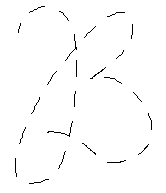
The law of closure says that, if something is missing in an otherwise complete figure, we will tend to add it. A triangle, for example, with a small part of its edge missing, will still be seen as a triangle. We will “close” the gap.
The law of similarity says that we will tend to group similar items together, to see them as forming a gestalt, within a larger form. Here is a simple typographic example:
OXXXXXXXXXX
XOXXXXXXXXX
XXOXXXXXXXX
XXXOXXXXXXX
XXXXOXXXXXX
XXXXXOXXXXX
XXXXXXOXXXX
XXXXXXXOXXX
XXXXXXXXOXX
XXXXXXXXXOX
XXXXXXXXXXO
It is just natural for us to see the o’s as a line within a field of x’s.
Another law is the law of proximity. Things that are close together as seen as belonging together. For example...
**************
**************
**************
You are much more likely to see three lines of close-together *’s than 14 vertical collections of 3 *’s each.
Next, there’s the law of symmetry. Take a look at this example:
[ ][ ][ ]
Despite the pressure of proximity to group the brackets nearest each other together, symmetry overwhelms our perception and makes us see them as pairs of symmetrical brackets.
Another law is the law of continuity. When we can see a line, for example, as continuing through another line, rather than stopping and starting, we will do so, as in this example, which we see as composed of two lines, not as a combination of two angles...:
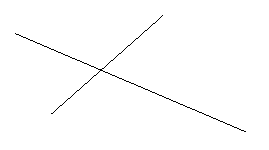
Figure-ground is another Gestalt psychology principle. It was first introduced by the Danish phenomenologist Edgar Rubin (1886-1951). The classic example is this one...

Basically, we seem to have an innate tendency to pereive one aspect of an event as the figure or fore-ground and the other as the ground or back-ground. There is only one image here, and yet, by changing nothing but our attitude, we can see two different things. It doesn’t even seem to be possible to see them both at the same time!
But the gestalt principles are by no means restricted to perception -- that’s just where they were first noticed. Take, for example, memory. That too seems to work by these laws. If you see an irregular saw-tooth figure, it is likely that your memory will straighten it out for you a bit. Or, if you experience something that doesn’t quite make sense to you, you will tend to remember it as having meaning that may not have been there. A good example is dreams: Watch yourself the next time you tell someone a dream and see if you don’t notice yourself modifying the dream a little to force it to make sense!
Learning was something the Gestalt psychologists were particularly interested in. One thing they noticed right away is that we often learn, not the literal things in front of us, but the relations between them. For example, chickens can be made to peck at the lighter of two gray swatches. When they are then presented with another two swatches, one of which is the lighter of the two preceding swatches, and the other a swatch that is even lighter, they will peck not at the one they pecked at before, but at the lighter one! Even something as stupid as a chicken “understands” the idea of relative lightness and darkness.
Gestalt theory is well known for its concept of insight learning. People tend to misunderstand what is being suggested here: They are not so much talking about flashes of intuition, but rather solving a problem by means of the recognition of a gestalt or organizing principle.
The most famous example of insight learning involved a chimp named Sultan. He was presented with many different practical problems (most involving getting a hard-to-reach banana). When, for example, he had been allowed to play with sticks that could be put together like a fishing pole, he appeared to consider in a very human fashion the situation of the out-of-reach banana thoughtfully -- and then rather suddenly jump up, assemble the poles, and reach the banana.
A similar example involved a five year old girl, presented with a geometry problem way over her head: How do you figure the area of a parallelogram? She considered, then excitedly asked for a pair of scissors. She cut off a triangle from one end, and moved it around to the other side, turning the parallelogram into a simple rectangle. Wertheimer called this productive thinking.
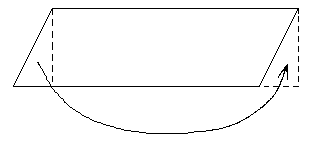
The idea behind both of these examples, and much of the gestalt explanation of things, is that the world of our experiencing is meaningfully organized, to one degree or another. When we learn or solve problems, we are essentially recognizing meaning that is there, in the experience, for the “dis-covering.”
Most of what we’ve just looked at has been absorbed into “mainstream” psychology -- to such a degree that many people forget to give credit to the people who discovered these principles! There is one more part of their theory that has had less acceptance: Isomorphism.
Isomorphism suggests that there is some clear similarity in the gestalt patterning of stimuli and of the activity in the brain while we are perceiving the stimuli. There is a “map” of the experience with the same structural order as the experience itself, albeit “constructed” of very different materials! We are still waiting to see what an experience “looks” like in an experiencing brain. It may take a while.
Kurt Lewin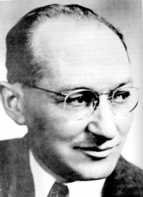
Gestalt Psychology, even though it no longer survives as a separate entity, has had an enormous impact. Two people in particular lead the way in introducing it into other aspects of psychology: Kurt Goldstein and Kurt Lewin.
Kurt Lewin was born September 9, 1890, in Mogilno, Poland. He received his PhD from the University of Berlin under Stumpf. After military service, he returned to Berlin where he worked with Wertheimer, Koffka, and Köhler.
He went to the U.S. as a guest lecturer at Stanford and Cornell, and took a position at the University of Iowa in 1935. In 1944, he created and directed the Research Center for Group Dynamics at MIT. He died in 1947, just beginning his work there.
Lewin created a topological theory that expressed human dynamics in the form of a map representing a person’s life space. The map is patterned with one’s needs, desires, and goal, and vectors or arrows indicating the directions and strengths of these forces -- all operating as a Gestalt.
This theory inspired any number of psychologists in the U.S., most particularly those in social psychology. Among the people he influenced were Muzafer Sherif, Solomon Asch, and Leon Festinger.
Kurt Goldstein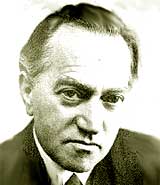
The other person was Kurt Goldstein. Born in 1878, he received his MD from the University of Breslau in 1903. He went to teach at the Neurological Institute of the University of Frankfurt, where he met the founders of Gestalt psychology.
He went to Berlin to be a professor there, and then went on to New York City in 1935. There, he wrote The Organism in 1939, and later Human Nature in the Light of Pathology in 1963. He died in 1965.
Goldstein developed a holistic view of brain function, based on research that showed that people with brain damage learned to use other parts of their brains in compensation. He extended his holism to the entire organism, and postulated that there was only one drive in human functioning, and coined the term self-actualization. Self-preservation, the usual postulated central motive, he said, is actually pathological!
Goldstein and his idea of self-actualization influence quite a few young personality theorists and therapists. Among them would be Gordon Allport, Carl Rogers, and Abraham Maslow, founders of the American humanistic psychology movement.
© Copyright C. George Boeree, 2000